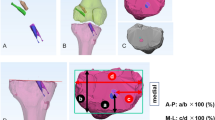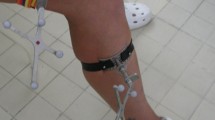Abstract
Purpose
The objective of this study was to evaluate knee kinematics during double-bundle posterior cruciate ligament reconstruction (DB-PCLR) intraoperatively using a navigation system, and especially assess biomechanical behaviour of the anterolateral bundle (ALB) and posteromedial bundle (PMB) graft in DB-PCLR. Also, clinical results of minimum 2-year follow-up were investigated.
Methods
Nine patients received DB-PCLR with hamstring graft. Before reconstruction, knee laxities, including posterior tibial translation (PTT) in neutral rotation at 15°, 30°, 45°, 60°, 75° and 90° of knee flexion, were measured using a kinematic-based navigation system. After the PMB or ALB was temporally fixed, the knee laxities were measured in the same manner. Each patient was evaluated pre- and post-operatively with side-to-side difference of tibial position in gravity sag view and Lysholm score.
Results
Both ALB and PMB fixation restrained the PTT compared to PCL deficiency throughout all knee flexion angles. At 90° of knee flexion, ALB fixation significantly decreased PTT compare to PMB fixation (p = 0.014) and DB-PCLR significantly decreased PTT compare to ALB fixation (p = 0.045). The mean side-to-side difference of tibial position in gravity sag view was 12.0 ± 1.7 mm preoperatively and 2.3 ± 1.8 mm at final follow-up, and the mean Lysholm scores were 68.9 ± 20.9 and 96.3 ± 2.9, respectively.
Conclusions
There were no significant differences in the PTT between ALB and PMB fixations at 0° to 75° of knee flexion, and both ALB and PMB reconstructions are important for restraining PTT. At 90° of knee flexion, the ALB grafts may be more important to control PTT compared to PMB grafts; however, neither single-bundle reconstruction with ALB nor PMB could function as DB-PCLR did. In addition, PTT after DB-PCLR was strongly correlated side-to-side difference in posterior sag view at the final follow-up. The results from this study indicated that both ALB and PMB are important to stabilize PCL-deficient knees.
Level of evidence
Therapeutic study, Level III.




Similar content being viewed by others
References
Ahmad CS, Cohen ZA, Levine WN, Gardner TR, Ateshian GA, Mow VC (2003) Codominance of the individual posterior cruciate ligament bundles. An analysis of bundle lengths and orientation. Am J Sports Med 31:221–225
Clancy WG Jr, Shelbourne KD, Zoellner GB, Keene JS, Reider B, Rosenberg TD (1983) Treatment of knee joint instability secondary to rupture of the posterior cruciate ligament. Report of a new procedure. J Bone Joint Surg Am 65:310–322
Colombet P, Robinson J, Christel P, Franceschi JP, Djian P (2007) Using navigation to measure rotation kinematics during ACL reconstruction. Clin Orthop Relat Res 454:59–65
Desai N, Bjo¨rnsson H H, Musahl V, Bhandari M, Petzold M, Fu FH, Samuelsson K (2014) Anatomic single-versus double-bundle ACL reconstruction: a meta-analysis. Knee Surg Sports Traumatol Arthrosc 22:1009–1023
Ettinger M, Petri M, Guenther D, Liu C, Krusche C, Liodakis E, Albrecht UV, Krettek C, Jagodzinski M (2013) Anatomic double-bundle ACL reconstruction restricts knee extension in knees with hypertension. Knee Surg Sports Traumatol Arthrosc 21:2057–2062
Fox RJ, Harner CD, Sakane M, Carlin GJ, Woo SLY (1998) Determination of the in situ forces in the human posterior cruciate ligament using robotic technology. A cadaveric study. Am J Sports Med 26:395–401
Girgis FG, Marshall JL, Monajem ARS (1975) The cruciate ligaments of the knee joint. Anatomical, functional and experimental analysis. Clin Orthop Relat Res 106:216–231
Gollehon DL, Torzilli PA, Warren RF (1987) The role of the posterolateral and cruciate ligaments in the stability of the human knee. A biomechanical study. J Bone Joint Surg Am 69:233–242
Grood ES, Stowers SF, Noyes FR (1988) Limits of movement in the human knee. Effect of sectioning the posterior cruciate ligament and posterolateral structures. J Bone Joint Surg Am 70:88–97
Hanner CD, Xerogeanes JW, Livesay GA, Carlin GJ, Smith BA, Kusayama T, Kashiwaguchi S, Woo SL (1995) The human posterior cruciate ligament complex: an interdisciplinary study. Ligament morphology and biomechanical evaluation. Am J Sports Med 23:736–745
Harner CD, Hoher J (1998) Evaluation and treatment of posterior cruciate ligament injuries. Am J Sports Med 26:471–482
Harner CD, Baek GH, Vogrin TM, Carlin GJ, Kashiwaguchi S, Woo SL (1999) Quantitative analysis of human cruciate ligament insertions. Arthroscopy 15:741–749
Harner CD, Janaushek MA, Kanamori A, Yagi M, Vogrin TM, Woo SL (2000) Biomechanical analysis of a double-bundle posterior cruciate ligament reconstruction. Am J Sports Med 28:144–151
Hiraga Y, Ishibashi Y, Tsuda E, Tsukada H, Toh S (2006) Biomechanical comparison of posterior cruciate ligament reconstruction techniques using cyclic loading tests. Knee Surg Sports Traumatol Arthrosc 14:13–19
Ishibashi Y, Tsuda E, Fukuda A, Tsukada H, Toh S (2008) Intraoperative biomechanical evaluation of anatomic anterior cruciate ligament reconstruction using a navigation system comparison of hamstring tendon and bone–patellar tendon–bone graft. Am J Sports Med 32:1903–1912
Ishibashi Y, Tsuda E, Yamamoto Y, Tsukada H, Satoshi T (2009) Navigation evaluation of the pivot-shift phenomenon during double-bundle anterior cruciate ligament reconstruction: is the posterolateral bundle more important? Arthroscopy 25:488–495
Koh J (2005) Computer-assisted navigation and anterior cruciate ligament reconstruction: accuracy and outcomes. Orthopedics 28(10 suppl):S1283–S1287
Koh J, Koo SS, Leonard J, Kodali P (2006) Anterior cruciate ligament (ACL) tunnel placement: a radiographic comparison between navigated versus manual ACL reconstruction. Orthopedics 29:S122–S124
Lysholm J, Gillquist J (1982) Evaluation of knee ligament surgery results with special emphasis on use of a scoring scale. Am J Sports Med 10:150–154
Mannor DA, Shearn JT, Grood ES, Noyes FR, Levy MS (2000) Two-bundle posterior cruciate ligament reconstruction. An in vitro analysis of graft placement and tension. Am J Sports Med 28:833–845
Markolf KL, Feeley BT, Tejwani SG, Martin DE, McAllister DR (2006) Changes in knee laxity and ligament force after sectioning the posteromedial bundle of the posterior cruciate ligament. Arthroscopy 22:1100–1106
Markolf KL, Feeley BT, Jackson SR, Mcallister DR (2006) Biomechanical studies of double-bundle posterior cruciate ligament reconstructions. J Bone Joint Surg 88:1788–1794
Nakamura N, Takeuchi R, Sawaguchi T, Ishikawa H, Saito T, Goldhahn S (2011) Cross-cultural adaptation and validation of the Japanese Knee Injury and Osteoarthritis Outcome Score (KOOS). J Orthop Sci 16:516–523
Papannagari R, DeFrate LE, Nha KW, Moses JM, Moussa M, Gill TJ, Li G (2007) Function of posterior cruciate ligament bundles during in vivo knee flexion. Am J Sports Med 35:1507–1512
Race A, Amis AA (1994) The mechanical properties of the two bundles of the human posterior cruciate ligament. J Biomech 27:13–24
Race A, Amis AA (1996) Loading of the two bundles of the posterior cruciate ligament: an analysis of bundle function in A-P drawer. J Biomech 29:873–879
Race A, Amis AA (1998) PCL reconstruction: in vitro biomechanical comparison of ‘‘isometric’’ versus single and double-bundles ‘‘anatomic’’ grafts. J Bone Joint Surg Br 80:173–179
Sekiya JK, West RV, Ong BC, Irrgang JJ, Fu FH, Harner CD (2005) Clinical outcomes after isolated arthroscopic single-bundle posterior cruciate ligament reconstruction. Arthroscopy 21:1042–1050
Shino K, Mitsuoka T, Horibe S, Hamada M, Nakata K, Nakamura N (2000) The gravity sag view: a simple radiographic technique to show posterior laxity of the knee. Arthroscopy 16:670–672
Tajima G, Nozaki M, Iriuchishima T, Ingham SJ, Shen W, Smolinski P, Fu FH (2009) Morphology of the tibial insertion of the posterior cruciate ligament. J Bone Joint Surg Am 91:859–866
Tegner Y, Lysholm J (1985) Rating systems in the evaluation of knee ligament injuries. Clin Orthop Relat Res 198:43–49
Tsuda E, Ishibashi Y, Fukuda A, Tsukada H, Toh S (2007) Validation of computer-assisted double-bundle anterior cruciate ligament reconstruction. Orthopedics 30:S136–S140
Tsukada H, Ishibashi Y, Tsuda E, Fukuda A, Yamamoto Y (2012) Biomechanical evaluation of an anatomic double-bundle posterior cruciate ligament reconstruction. Arthroscopy 28:264–271
Yang JH, Yoon JR, Jeong H, Hwang DH, Woo SJ, Kwon JH, Nha KW (2012) Second-look arthroscopic assessment of arthroscopic single-bundle posterior cruciate ligament reconstruction comparison of mixed graft versus achilles tendon allograft. Am J Sports Med 40:2052–2060
Acknowledgments
We thank Eiji Sasaki, MD, Hirosaki University Graduate School of Medicine, for statistical analysis and data processing.
Conflict of interest
The authors declare that they have no conflict of interest.
Author information
Authors and Affiliations
Corresponding author
Rights and permissions
About this article
Cite this article
Kimura, Y., Tsuda, E., Hiraga, Y. et al. Intraoperative laxity measurements using a navigation system in anatomical double-bundle posterior cruciate ligament reconstruction. Knee Surg Sports Traumatol Arthrosc 23, 3085–3093 (2015). https://doi.org/10.1007/s00167-014-3418-2
Received:
Accepted:
Published:
Issue Date:
DOI: https://doi.org/10.1007/s00167-014-3418-2




